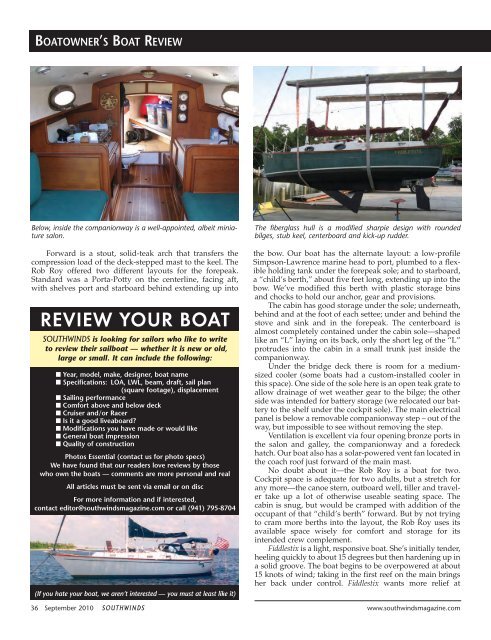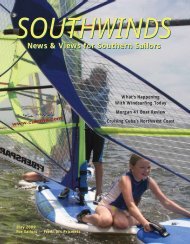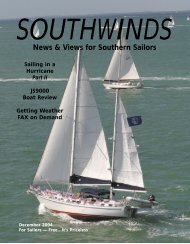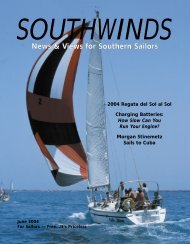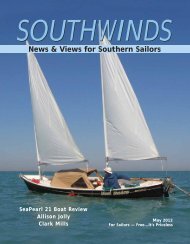Read PDF - Southwinds Magazine
Read PDF - Southwinds Magazine
Read PDF - Southwinds Magazine
Create successful ePaper yourself
Turn your PDF publications into a flip-book with our unique Google optimized e-Paper software.
BOATOWNER’S BOAT REVIEW<br />
Below, inside the companionway is a well-appointed, albeit miniature<br />
salon.<br />
Forward is a stout, solid-teak arch that transfers the<br />
compression load of the deck-stepped mast to the keel. The<br />
Rob Roy offered two different layouts for the forepeak.<br />
Standard was a Porta-Potty on the centerline, facing aft,<br />
with shelves port and starboard behind extending up into<br />
REVIEW YOUR BOAT<br />
SOUTHWINDS is looking for sailors who like to write<br />
to review their sailboat — whether it is new or old,<br />
large or small. It can include the following:<br />
■ Year, model, make, designer, boat name<br />
■ Specifications: LOA, LWL, beam, draft, sail plan<br />
(square footage), displacement<br />
■ Sailing performance<br />
■ Comfort above and below deck<br />
■ Cruiser and/or Racer<br />
■ Is it a good liveaboard<br />
■ Modifications you have made or would like<br />
■ General boat impression<br />
■ Quality of construction<br />
Photos Essential (contact us for photo specs)<br />
We have found that our readers love reviews by those<br />
who own the boats — comments are more personal and real<br />
All articles must be sent via email or on disc<br />
For more information and if interested,<br />
contact editor@southwindsmagazine.com or call (941) 795-8704<br />
(If you hate your boat, we aren’t interested — you must at least like it)<br />
The fiberglass hull is a modified sharpie design with rounded<br />
bilges, stub keel, centerboard and kick-up rudder.<br />
the bow. Our boat has the alternate layout: a low-profile<br />
Simpson-Lawrence marine head to port, plumbed to a flexible<br />
holding tank under the forepeak sole; and to starboard,<br />
a “child’s berth,” about five feet long, extending up into the<br />
bow. We’ve modified this berth with plastic storage bins<br />
and chocks to hold our anchor, gear and provisions.<br />
The cabin has good storage under the sole; underneath,<br />
behind and at the foot of each settee; under and behind the<br />
stove and sink and in the forepeak. The centerboard is<br />
almost completely contained under the cabin sole—shaped<br />
like an “L” laying on its back, only the short leg of the “L”<br />
protrudes into the cabin in a small trunk just inside the<br />
companionway.<br />
Under the bridge deck there is room for a mediumsized<br />
cooler (some boats had a custom-installed cooler in<br />
this space). One side of the sole here is an open teak grate to<br />
allow drainage of wet weather gear to the bilge; the other<br />
side was intended for battery storage (we relocated our battery<br />
to the shelf under the cockpit sole). The main electrical<br />
panel is below a removable companionway step – out of the<br />
way, but impossible to see without removing the step.<br />
Ventilation is excellent via four opening bronze ports in<br />
the salon and galley, the companionway and a foredeck<br />
hatch. Our boat also has a solar-powered vent fan located in<br />
the coach roof just forward of the main mast.<br />
No doubt about it—the Rob Roy is a boat for two.<br />
Cockpit space is adequate for two adults, but a stretch for<br />
any more—the canoe stern, outboard well, tiller and traveler<br />
take up a lot of otherwise useable seating space. The<br />
cabin is snug, but would be cramped with addition of the<br />
occupant of that “child’s berth” forward. But by not trying<br />
to cram more berths into the layout, the Rob Roy uses its<br />
available space wisely for comfort and storage for its<br />
intended crew complement.<br />
Fiddlestix is a light, responsive boat. She’s initially tender,<br />
heeling quickly to about 15 degrees but then hardening up in<br />
a solid groove. The boat begins to be overpowered at about<br />
15 knots of wind; taking in the first reef on the main brings<br />
her back under control. Fiddlestix wants more relief at<br />
36 September 2010 SOUTHWINDS www.southwindsmagazine.com


